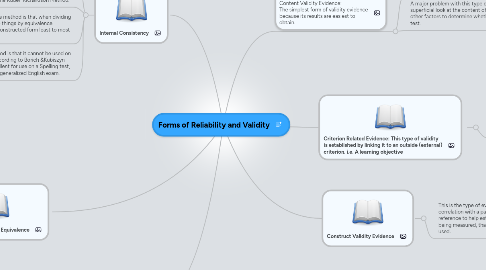Forms of Reliability and Validity
by Danielle Hosey


1. Internal Consistency
1.1. Seeks to check whether items on a single test relate to one another.
1.2. Reliability through this method can be done by one of the split halves methods: odd/even reliability or by the Kuder-Richardson Method.
1.3. The problem with using this method is that when dividing a test, it is hard to measure things by equivalence because tests are usually constructed form least to most difficult
1.4. Another concern with this method is that it cannot be used on tests with multiple sections. According to Borich &Kubiszyn (2010, pg 345) it would be excellent for use on a Spelling test, but not good for use on a more generalized English exam.
2. Alternative Forms of Equivalence
2.1. 2 Equal forms of the same test are administered and reliability is is obtained as an estimate from both scores.
2.2. This method eliminates the problem of the test possibly being memorized.
2.3. The problem with this method is that it is very difficult to produce two well developed tests.
3. Test/Re-Test Method
3.1. This method is also known as stability.
3.2. Reliability is estimated by giving the test more than once.
3.3. The problem with this method is in timing. Once the first test is given, you have to give consideration to how soon the test will be re-administered.
4. Content Validity Evidence: The simplest form of validity evidence because its results are easiest to obtain.
4.1. Results are obtained by checking to see if the test is performing the way it is supposed to. For instance in administering a mathematics test checking for acquired ability in multiplication, you would want to be sure that
4.2. A major problem with this type of evidence is that it is an almost superficial look at the content of the test. It doesn't look at any other factors to determine whether the test is actually a good test.
5. Criterion Related Evidence: This type of validity is established by linking it to an outside (external) criterion. i.e. A learning objective
5.1. There are two types of Criterion Related Evidence:
5.1.1. CONCURRENT: which takes the means of measurement and applies it to the thing being measured at the time of administration. (The test being measured while it is being given)
5.1.2. PREDICTIVE: evidence that foretells future behaviors i.e. the SAT-II- which is used to help with admitting students into college because it is an indicator of how well a student WILL do.
